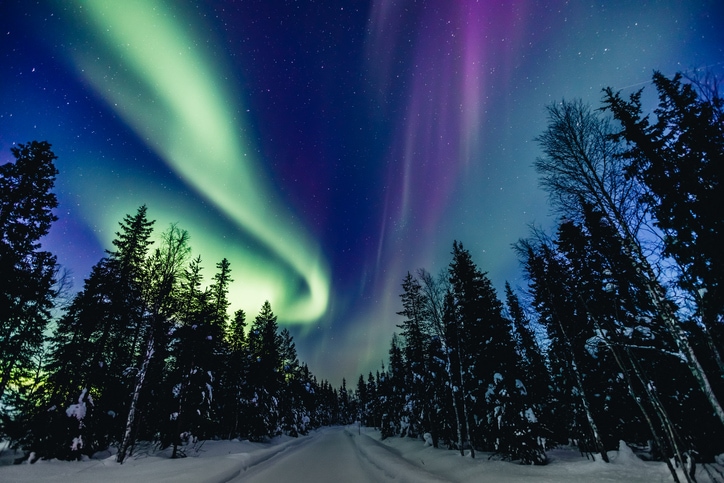Can You Predict When Aurora Borealis Will Occur?
At VALO Finland, we are passionate about sharing the wonders of Lapland with our guests. One of the most awe-inspiring natural phenomena you can experience here is the aurora borealis, or northern lights. But can you predict when this magical display will occur? In this blog post, we delve into the science and techniques behind aurora prediction, providing you with a comprehensive understanding of this captivating spectacle.
What is the Aurora Borealis?
The aurora borealis, commonly known as the northern lights, is a natural light display predominantly seen in high-latitude regions around the Arctic and Antarctic. This phenomenon occurs when charged particles from the sun collide with atoms in Earth’s atmosphere, resulting in bursts of light that can illuminate the night sky with vibrant colours such as green, pink, red, and violet.
These lights are not only a visual delight but also a significant cultural and historical symbol for many indigenous communities in the Arctic regions. The aurora borealis has inspired countless myths and legends, adding to its mystique and allure.
The Science Behind the Northern Lights
The northern lights are a result of complex interactions between solar wind, Earth’s magnetic field, and the atmosphere. Solar wind, a stream of charged particles emitted by the sun, travels through space and interacts with Earth’s magnetosphere. When these particles collide with gases like oxygen and nitrogen in the atmosphere, they excite the atoms, causing them to emit light.
The colours of the aurora depend on the type of gas involved and the altitude at which the collisions occur. For instance, oxygen at higher altitudes (above 150 miles) produces red auroras, while at lower altitudes (up to 60 miles), it emits green light. Nitrogen, on the other hand, can produce blue or purplish-red auroras.
How is the Aurora Borealis Predicted?
Aurora prediction involves monitoring solar activity and space weather conditions. Scientists use data from satellites and ground-based observatories to track solar wind and geomagnetic storms, which are disturbances in Earth’s magnetosphere caused by solar wind. By analysing this data, they can estimate the likelihood of auroral activity.
One of the key indicators used in aurora prediction is the Kp index, a scale that measures geomagnetic activity. The higher the Kp index, the more likely it is that the northern lights will be visible. Other factors, such as local weather conditions and light pollution, also play a role in determining the visibility of the aurora borealis.
Tools and Techniques for Aurora Forecasting
Several tools and techniques are employed to forecast the aurora borealis. These include:
- Space Weather Satellites: Satellites like the Solar and Heliospheric Observatory (SOHO) and the Advanced Composition Explorer (ACE) provide real-time data on solar wind and geomagnetic activity.
- Ground-Based Observatories: Networks of observatories around the world monitor geomagnetic activity and provide valuable data for aurora forecasting.
- Online Forecasting Services: Websites and apps such as the NOAA Space Weather Prediction Center and the Aurora Service offer real-time aurora forecasts and alerts based on the latest data.
- Local Expertise: Experienced local guides and photographers in Lapland can provide valuable insights and tips for aurora hunting, increasing your chances of witnessing this natural wonder.
Challenges in Predicting the Northern Lights
Despite advances in technology and our understanding of space weather, predicting the aurora borealis remains a challenging task. Solar activity is inherently unpredictable, and geomagnetic storms can vary in intensity and duration. Additionally, local weather conditions, such as cloud cover, can obscure the northern lights, making them difficult to see even when geomagnetic activity is high.
Another challenge is the variability in auroral displays. While some nights may feature spectacular, vivid auroras, others may only show faint glows. This unpredictability adds to the excitement and allure of aurora hunting, as each experience is unique and unforgettable.
At VALO Finland, we strive to provide our guests with the best possible opportunities to witness the northern lights. By staying informed about aurora forecasts and working with experienced local guides, we aim to enhance your chances of experiencing this magical phenomenon. Whether you’re relaxing in one of our luxurious VALO Ice Cube Villas or exploring the stunning landscapes of Lapland, the northern lights are a sight you won’t want to miss.
We invite you to join us in Lapland and immerse yourself in the beauty and wonder of the aurora borealis. With our expert guidance and luxurious accommodations, your journey to witness the northern lights will be an unforgettable adventure. Welcome to VALO Finland, where the magic of Lapland awaits.
